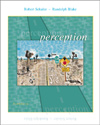| analytic introspection | A method for studying perception in which trained people attend to and describe the experiences evoked by some stimulus.
|
 |
 |
 |
| closure | The Gestalt principle of organization referring to the tendency of the visual system to obscure small breaks or gaps in objects. See proximity, similarity.
|
 |
 |
 |
| contrast | The difference in light intensity between an object and its immediate surroundings; also, the intensity difference between adjacent bars in a grating.
|
 |
 |
 |
| configural superiority effect | The finding that, under some circumstances, a complex figure, or part of a complex figure, may be seen more readily than one of its parts presented in isolation.
|
 |
 |
 |
| contrast sensitivity function (CSF) | A graph depicting a person's ability to see targets of various spatial frequency; on the x-axis is the spatial frequency of the test target; on the y-axis is sensitivity, the reciprocal of the minimum contrast needed to see the test target.
|
 |
 |
 |
| contrast threshold | The minimum contrast needed to see some target.
|
 |
 |
 |
| cutoff frequency | The spatial frequency at which a lens's transfer function falls to zero; the highest frequency that a lens can image; the highest frequency to which a visual system can respond.
|
 |
 |
 |
| detection | The process by which an object is picked out from its surroundings; also, the process by which the presence of some object is perceived.
|
 |
 |
 |
| discrimination | The process by which one object is distinguished from another.
|
 |
 |
 |
| Fourier analysis | A method for calculating the frequency content of any temporal or spatial signal; can be used to determine the spatial frequency content of a visual scene or other target.
|
 |
 |
 |
| good continuation | The tendency to see neighboring elements as grouped together when they are potentially connected by straight or smoothly curving lines.
|
 |
 |
 |
| grating | A target consisting of alternating darker and lighter bars, used to study spatial vision. See sinusoidal grating.
|
 |
 |
 |
| Gestalt principles of organization | Certain stimulus properties that control the perceptual grouping of objects. See closure, good continuation, proximity, similarity.
|
 |
 |
 |
| identification | The process of distinguishing a particular object.
|
 |
 |
 |
| metamers | Two or more objects that appear identical despite acute physical differences.
|
 |
 |
 |
| multichannel model | The hypothesis that spatial vision is the product, in part, of sets of neurons responsive to different spatial frequencies.
|
 |
 |
 |
| orientation | The degree of inclination of a contour within a two-dimensional plane.
|
 |
 |
 |
| proximity | The Gestalt principle of organization referring to the perceptual tendency to group together objects that are near one another. See closure, similarity.
|
 |
 |
 |
| scale | Relative size or extent.
|
 |
 |
 |
| selective adaptation | A method of studying mechanisms of perception, in which a person's sensitivity to particular targets is depressed by prolonged exposure to one particular target.
|
 |
 |
 |
| shape constancy | The tendency for an object's perceived shape to remain constant despite changes in the shape of the retinal image of that object.
|
 |
 |
 |
| similarity | The Gestalt principle of organization referring to the perceptual tendency to group together objects that are similar to one another in texture, shape, and so on. See closure, proximity.
|
 |
 |
 |
| sinusoidal grating | A target in which the intensity of darker and lighter bars varies sinusoidally over space. See grating.
|
 |
 |
 |
| size aftereffect | A change in the apparent size of an object following inspection of an object of a different size.
|
 |
 |
 |
| spatial frequency | For a grating target, the number of pairs of bars imaged within a given distance on the retina; units of spatial frequency are cycles/mm or, equivalently, cycles/degree of visual angle.
|
 |
 |
 |
| spatial phase | The position of a grating relative to some visual landmark.
|
 |
 |
 |
| transfer function | A graph showing, for various target spatial frequencies, the contrast contained in an image.
|
 |
 |
 |
| window of visibility | The range of spatial frequencies that, with sufficient contrast, an observer can see.
|



 2002 McGraw-Hill Higher Education
2002 McGraw-Hill Higher Education

 2002 McGraw-Hill Higher Education
2002 McGraw-Hill Higher Education